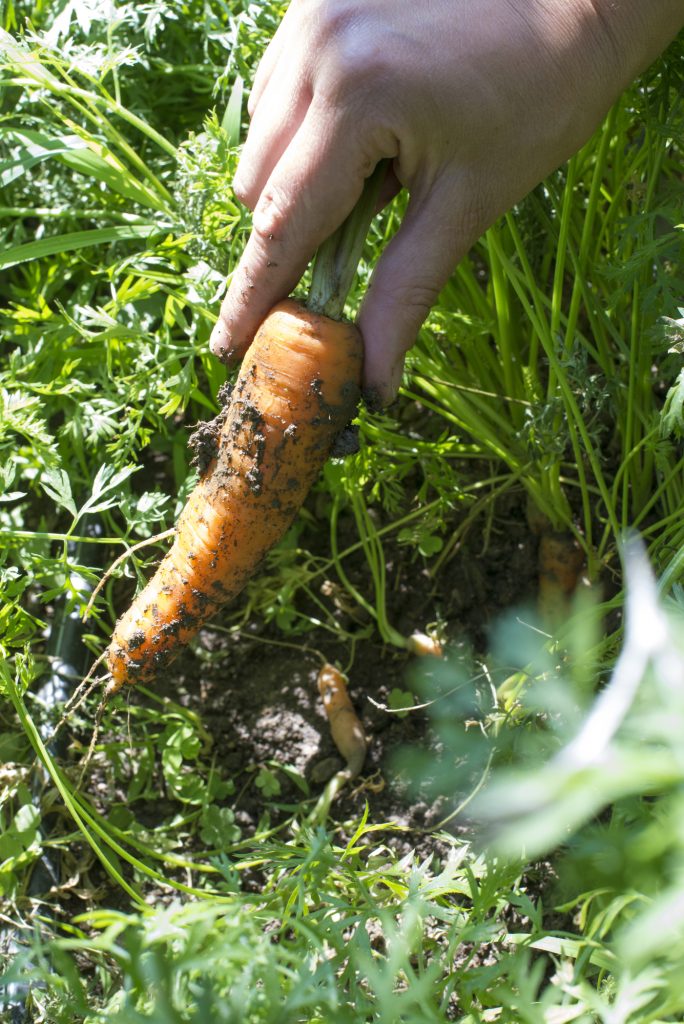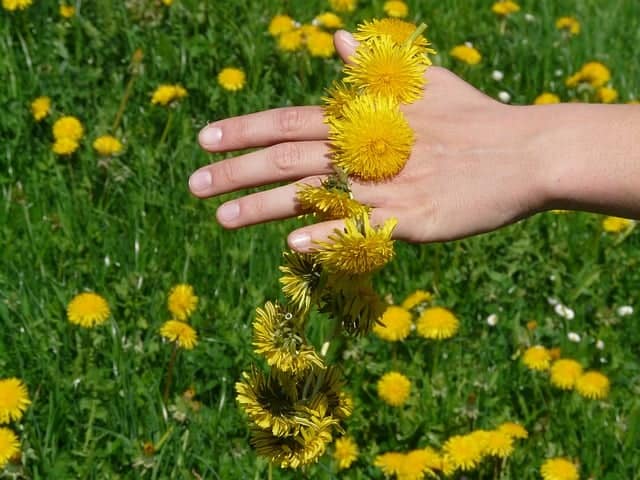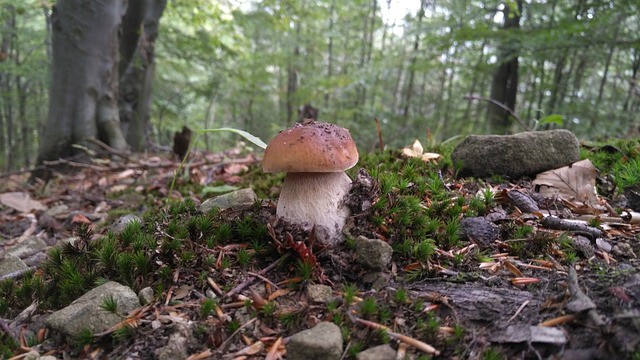Wildcrafting herbs and other edible plants is a unique way to save money and go green at the same time. From reading wildcrafting books to finding wildcrafting classes near you, educate yourself before you start.
These wildcrafting tips are just the beginning of what you need to know before you start foraging for food! If you love the idea of eating local foods, you should start wildcrafting!
Posts feature partner companies & may be sponsored. Post contains affiliate links & I will be compensated if you make a purchase after clicking on links. As an Amazon Associate I earn from qualifying purchases.

Table of Contents
Why Harvest Wild Plants?
At the top of many people’s minds is reducing their grocery bills. I’m sure you’ve heard people talk about clipping coupons, shopping on sale, cooking from scratch and growing your own garden.
Have you considered the concept of eating the food that’s right outside your front door? No, I don’t mean in your garden. I mean the food that grows wild in the fields and woods and by streams in your neighborhood, otherwise known as foraging or wildcrafting. Foraging for food is one reason people start wildcrafting.
From reducing your carbon footprint to eating as locally as possible, there are many reasons why people start eating dandelions and mushrooms from their local area.
Of course, wildcrafting medicinal herbs is also popular (check out my post on medicinal herb gardening if you would like to grow your own). Check out United Plant Savers for information about conservation of medicinal plants.

✯Don’t want to miss the next post?✯
Follow Turning the Clock Back on Facebook | Twitter | Pinterest
Or join the private Facebook group for simple tips on going green!
Wildcrafting vs Foraging
Is there a difference between wildcrafting and foraging? No.
There are many wild edible and medicinal plants. Harvesting these wild plants is called Wildcrafting. Any plant harvested for food or medicinal purposes from it’s ‘wild’ or natural habitat has been ‘foraged’.
Whether you want to develop a natural skincare routine or tackle your own health care using herbal medicine, many species can be found in the areas around your home.

How to Start Wildcrafting
Whether you want to start wildcrafting for profit or just want to try out a cool dandelion recipe you found on Pinterest, don’t just head out into the woods without a plan. Learn how to identify wild herbs and food first. And then, get prepared to forage!
Wildcrafting Books:
Before you start, you need few good reference books like Stalking the Wild Asparagus by Euell Gibbons and The Foragers Harvest by Samuel Thayer. Buy a good plant identification guide to help you identify plant species, especially poisonous plants!
Try to find plant guides for your region that discuss which plants are edible and which are not. You can get some specific information about foraging for food in Vermont on Confessions of an Overworked Mom.
Small Gardening Tools:
You are going to need small hand tools and a belt of some sort to take your things into the woods. You may need to dig out roots, snip off small limbs, or carry home berries.
A set of small gardening tools will come in very handy when you start wildcrafting.
The right clothes:
You are heading into the woods where streams run and deer poop. A pair of waterproof hiking boots and other appropriate clothing, sun protection, bug spray, and hat are all a good idea before you start wildcrafting!

Harvesting Dandelions
Consider starting with the easiest of wild edibles, dandelion greens. Most people can identify a dandelion without any problem at all. The greens (leaves) are wonderful when picked in very early spring before the flower has bloomed.
They can be eaten raw in a salad much like arugula can or they can be cooked like spinach. Harvesting dandelions is a very easy way to start wildcrafting without too much fear of poisoning yourself! (Check out my post on other edible flowers that go great on salads or desserts)

Wildcrafting Tips for Beginners
There are a few rules to remember when wildcrafting. These will keep you safe and reduce the risk of injury and/or liability.
- Always have permission from the land owner if you’re wildcrafting on someone else’s property.
- Never wildcraft on the edge of the road, near power lines, or anywhere else that’s liable to be sprayed with pesticides or exposed to car exhaust.
- Make certain that you are positive about what you’re picking when you pick it. A good wildcrafting book has pictures and detailed diagrams. If what you’re picking doesn’t match 100%, don’t pick it.
- Look for wild plant communities in your area. There are lots of people who love harvesting plants from nature and they are a great resource.
- Leave rare and endangered plants alone, even if they are edible. Be a good steward of the planet and leave the natural world a better place when you leave it.

Reasons to Start Wildcrafting
There are many reasons why people start wildcrafting. Your reasons to start wildcrafting may differ completely from someone else’s. However, if this is something you are on the fence about, here are a few benefits to foraging for food.
- Foraging is a fun activity to do with kids and teaches both you AND them a greater appreciation for nature.
- A large percentage of what can be foraged are actually non-native and invasive plants. By removing them, you are doing your local environment a huge favor!
- Wild edibles are good for you. Many are considered superfoods and wild foods are a great source of organic, non-GMO food.
- Foraging for your own food is a great way to save money on your grocery bill and save money on organic food.
- Pass on knowledge to future generations. If we forget about our foraging roots completely, who will know the secrets to wildcrafting that we learned hundreds of years ago?
- Explore new flavors. Did you know that certain edible flowers have a spicy flavor? What do nettles taste like? Broaden your taste buds by exploring wild foods.
- Use wild products for health and medicine as well as food. Check out the video below from Wildcrafter TV on how to make dandelion salve.
Tread Lightly While Wildcrafting!
When you wildcraft, you want to make sure you are only taking the part of the plant you need. If you’re picking dandelion greens, don’t yank the whole plant out of the ground, gently remove the leaves you need and let the rest of the plant remain in the ground so it can come up again next year and feed you or someone else again.
If you are harvesting something that requires you to remove the whole plant, like a wild leek where you use the bulb of the plant, do not harvest every single plant in the area. Leave some for someone else. This also lets the remaining plants multiply and divide so they come back next year.

Recipes Using Wild Foods
There are an amazing number of ways to use wild foods in your recipes. Here are just a few that I have come across recently:
- Dandelion Egg Noodles
- Dandelion Peanut Butter Cookies
- Wild Mushroom Risotto
- Rose Hip Tea
- Wild Violet Vinegar
Wildcrafting can be a lot of fun and it’s a great way to supplement your groceries. What’s available will depend on where you live in the United States as well as the countryside.
You will find different plants near streams, in fields and in the woods. Arm yourself with a good guidebook, a heavy pair of shoes, and a basket to hold your harvest. Start out small and try something new today!
Remember, it is vitally important that you learn about identifying plants before you start. Do you plan to start wildcrafting this spring?

Diane is a professional blogger and nationally certified pharmacy technician at Good Pill Pharmacy. She earned her BS in Microbiology at the University of New Hampshire and has worked in cancer research, academics, and biotechnology. Concern over the growing incidence of human disease and the birth of her children led her to begin living a more natural life. She quickly realized that the information she was learning along the way could be beneficial to many others and started blogging and freelance writing to share this knowledge with others. Learn more about her HERE.

I grew up in the midwest in the country and we bought almost nothing. Now I am a lazy city girl that buys everything. Shame! And you’re right, many things we grew in our gardens but a lot of things we had just naturally growing wild.
Blessings
Michelle V
Wow, this is very interesting! I will have to see where I could do that around here!!! Great post!
I could happily do the wild onions greens, and asparagus but I think, I too would skip over the crickets!
Every time I come here I learn something new. When I was a kid, my uncle and I would ramble through the woods for mushrooms. It always amazed me that he could figure our just which ones to pick.
This sounds like it would be an interesting way to reduce the grocery bill without a big expense up front, like putting a garden in can be. That’s one of the reasons I haven’t had a vegetable garden in years. Our soil is horrible, so it’s raised beds or nothing around here and I find the expense is such a killer.
Thanks for a great post ladies.
Cheryl
I’ve never wildcrafted nor do I believe I’ve eaten dandelion greens. Is it added to salads or chopped up for something else?
Cheryl, I have always been curious about harvesting mushrooms but they scare me! I always worry about eating something poisonous or having some weird psychological response!
My kids do love picking the wild onions in my yard but they are hard to pick from our clay soil!
Farrah, dandelion greens are just used like lettuce. In a salad or on a sandwich. If you don’t get them early they are bitter, though. My grandmother used to pick them, along with the wild strawberries.
Wow, very cool and informative. I swear, Diane, you and Ellen are a fountain of knowledge that I find fascinating. Thanks for sharing this! I do have to say that I, personally, would be to chicken to do this – I won’t even go mushroom hunting for fear of getting the wrong thing, lol.
My Mom used to say that dandelions are good for you. Still, the way people are spraying their yards, you have to be careful where you get the dandelions or you may end up with some very bad chemicals inside of you.
Morgan Mandel
http://morganmandel.blogspot.com
I admire people who know enough about plants to do this.
Are there “guides” who take people on little trips in the country for this sort of thing? If so, that’s the way I’d start out. I’m too scared to just pick stuff and eat it on my own. I’m afraid I’d pick THE absolute worst, most deadly thing out there and end it all for my entire family.
I know I have seen an advertisement either in Audobon or Vermont Living for a couple that goes around the country giving seminars. You can also check out http://www.wildcrafting.com/ for more info.
I would have to do this in a place that I knew wasnt sprayed. Or, in my yard, a place I know my dog hasnt peed 🙂
I live in Los Angeles and there’s nothing wild to harvest out here. And the only things on the sides of the road is roadkill and car parts. You must live in a very nice peopless area.